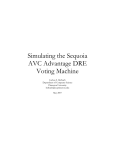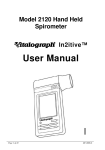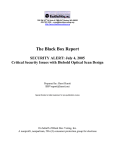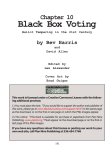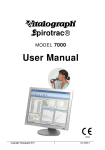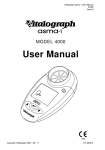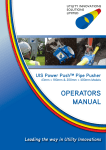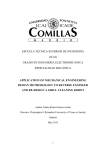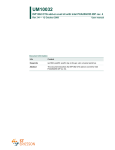Download Chapter 9 - Black Box Voting
Transcript
The First Public Look ... 85 This free internet version is available at www.BlackBoxVoting.org Black Box Voting — © 2004 Bev Harris Rights reserved. ISBN 1-890916-90-0. Papberback version can be purchased at www.Amazon.com 9 The First Public Look – Ever – into a secret voting system Author and historian Thom Hartmann writes: 1 “You’d think in an open democracy that the government — answerable to all its citizens rather than a handful of corporate officers and stockholders — would program, repair, and control the voting machines. You’d think the computers that handle our cherished ballots would be open and their software and programming available for public scrutiny. ... You’d be wrong. If America still is a democratic republic, then We, The People still own our government. And the way our ownership and management of our common government (and its assets) is asserted is through the vote. ... Many citizens believe, however, that turning the programming and maintenance of voting over to private, for-profit corporations, answerable only to their owners, officers, and stockholders, puts democracy itself at peril.” Historians will remind us of a concept called “the public commons.” Public ownership and public funding of things that are essential to everyone means we get public scrutiny and a say in how things are run. This free internet version is available at www.BlackBoxVoting.org 86 Black Box Voting When you privatize a thing like the vote, strange things happen. For example, you can’t ask any questions. Jim March, a California Republican, filed a public-records request2 in Alameda County, California, to ask about the voting machines it had entrusted with his vote. The county's reply: 3 “Please be advised that the county will not provide the information you requested ... The County will not allow access or disclose any information regarding the Diebold election system as any information relating to that system is exempted from the PRA (Public Records Act) ... The system provided by Diebold Election Systems Inc. (“DESI”) is a proprietary system that is recognized as such in the contract between the County and DESI... “The County contends that the official information privilege in section 1040 of the Evidence Code is applicable because the information requested was acquired by the County in confidence and the County is required to maintain its confidentiality. Any copying or disclosing of such information would violate the license agreements...” When I called ES&S to ask the names of its owners, the company simply declined to take my call. When former Boca Raton, Florida, mayor Emil Danciu requested that Dr. Rebecca Mercuri, perhaps the best-known expert on electronic voting in America, be allowed to examine the inner workings of Palm Beach County’s Sequoia machines, the judge denied the request, ruling that neither Mercuri nor anyone else would be allowed to see the code to render an opinion. 4 When best-selling author William Rivers Pitt interviewed Dr. David Dill, a professor of computer science at Stanford University, about his experience with voting machines, Pitt got an earful about secrecy: “It is frustrating because claims are made about these systems, how they are designed, how they work, that, frankly, I don’t believe,” says Dill. “In some cases, I don’t believe it because the claims they are making are impossible. I am limited in my ability to refute these impossible claims because all the data is hidden behind a veil of secrecy.” 5 When members of the California Task Force on Electronic Voting asked how the machines were tested, Wyle and Ciber declined to answer. “We wanted to know what these ITAs do,” said Dill. “So we invited them to speak to us. ... They refused to come visit us. They were also This free internet version is available at www.BlackBoxVoting.org Black Box Voting © 2004 Bev Harris • ISBN 1-890916-90-0 The First Public Look ... 87 too busy to join us in a phone conference. Finally, out of frustration, I wrote up 10 or 15 questions and sent it to them via the Secretary of State’s office. They didn’t feel like answering those questions, either.” “What testing do the manufacturers do?” asks Dill. “If you go to their Web pages, it says ‘if you’d like to know something about us, please go to hell’ in the nicest possible way.” You can’t examine a machine or even look at a manual. David Allen, who published an Internet version of this book, wanted me to find out how the machines work. “These things are so secret we’re supposed to just guess whether we can trust them,” he said. “We’ve got to get our hands on a technical manual somehow.” He didn’t have that information, and neither did anyone else. I decided to find some programmers for the vendors. I was most interested in ES&S — at that time, I hadn’t done much work at all on Diebold Election Systems. I entered “@essvote.com” into the Google search engine, looking for e-mails that might give me names I could contact, and found a few dozen employees who work for ES&S. I postponed calling them. What would I say? So I stalled by convincing myself that I should find as many names as possible. I got some from Sequoia. I entered “Global Election Systems” and found some old documents with e-mails ending in “gesn.com.” On page 15 of Google, looking for anything with “gesn” in it, I found a Web page. (You can still find this page at www.archive.org for GESN.com. The FTP link still appears.) Old Global Election Systems Web page: GESN.com This free internet version is available at www.BlackBoxVoting.org 88 Black Box Voting I clicked all the links, including the link called “FTP,” which took me to a page full of files. I called David Allen. “What am I looking at?” Allen admitted that the file names, like “BS4” and “GA-062802” meant nothing to him, but we both knew that this was an online file stash. He snorted and offered a comment: “Incredible stupidity.” I’d found the crown jewels for Diebold Election Systems. What follows is the first detailed look — ever — into a secret voting system. (Noun or verb?) What do you do when you find 40,000 secret files on an unprotected file transfer site on the Internet? Probably just look and go away. But what if you have pledged allegiance to the United States, and to the republic for which it stands? What if you knew that the devil went down to Georgia on November 5, 2002, and handed that state an election with six upsets, tossing triple-amputee war veteran Max Cleland out of the U.S. Senate in favor of a candidate who ran ads calling Cleland unpatriotic? Suppose you knew that in Georgia, the first Republican governor in 134 years had been elected despite trailing in every poll, and that African American candidates fared poorly even in their own districts? This free internet version is available at www.BlackBoxVoting.org Black Box Voting © 2004 Bev Harris • ISBN 1-890916-90-0 The First Public Look ... 89 If you learned that these machines had been installed just prior to an election — and then you saw a folder called “rob-georgia,” looked inside, and found instructions to replace the files in the new Georgia voting system with something unknown, what would you do? I don’t know about you, but I’m a 52-year old grandma and I never expected to have to make a choice like this. I wanted someone else to take care of it. We need investigators like Woodward and Bernstein, I thought, so I called the Washington Post. Of course, Carl Bernstein isn’t there anymore, but I left a spicy message on Bob Woodward’s voicemail. Never heard from anyone. I learned that reporter Dan Keating was doing a story on voting machines, so I called him. “Will you call Diebold and find out what ‘rob-georgia’ is?” I asked. “No.” “Why not?” “Because I don’t think ‘rob-georgia’ could possibly mean rob Georgia,” he said. I left a somewhat more agitated message on Woodward’s voicemail and submitted my experience to a Web site called Media Whores Online. These files might contain evidence. These files might go away. I called people in various places around the world and urged them to go look at rob-georgia. I thought long and hard. And then I downloaded the files, all 40,000 of them. It took 44 hours nonstop. I gave them to someone I trust, who put them in a safe deposit box, and there they sit to this day. Why in the world would an ATM manufacturer like Diebold leave sensitive files hanging out there on an unprotected Internet site? I made a few phone calls, which confirmed that Diebold knew the site was unprotected, and learned that the site had been there for years. I kept asking if anyone knew who Rob was. Everyone told me there was no employee named Rob in Georgia. Perhaps rob was a verb? This free internet version is available at www.BlackBoxVoting.org 90 Black Box Voting “rob-georgia” is a compressed folder with three more folders, containing 3,794 more files, inside it. It contains uncertified program modifications, a way to slip any damn thing you want into a voting machine. Why did they replace voting-machine stuff? Did they replace votingmachine files? As I Googled around with various “Georgia, voting machine, Diebold” search words, here’s what popped out: 16 Sep 2002 Memo from Chris Riggall (press secretary for Georgia Secretary of State Cathy Cox): “Diebold programmers developed a patch which was applied to the units deployed in Hall and Marion counties, and we were pleased that not one freeze was reported among the tens of thousands of votes cast there. Unfortunately, we simply did not have the time to apply the patch to the demo units, but that is now occurring to all units in all counties and the last increment of shipments from Diebold had this fix loaded before leaving the factory.”6 A program modification was needed because the touch-screens were freezing up, crashing the machines. Makes sense. The problem must be a big one to justify modifying the progam on all 22,000 machines in Georgia. But wait a minute — This is in the Media Backgrounder put out by the Georgia Secretary of State Press Office. 7 “Before being considered for acquisition in Georgia ... software is examined for reliability and hardware is subjected to a variety of ‘torture tests.’ The state testing examines both hardware and software for accuracy and reliability, and mock elections are conducted on the equipment, witnessed by county election officials.” The document names Wyle Laboratories and Ciber, Inc., citing their “extensive experience in NASA-related testing.” So how did these NASA-testing labs miss something so obvious that all 22,000 voting machines required a modifications to keep them from crashing? Here is what Diebold wrote to certifier Wyle Laboratories in its latest touch-screen certification documents: “It is Diebold Election Systems, Inc. policy that the only acceptable level of conformance is Zero Defects.” 8 This free internet version is available at www.BlackBoxVoting.org Black Box Voting © 2004 Bev Harris • ISBN 1-890916-90-0 The First Public Look ... 91 Okay, we all know that “zero defects” is one of those terms that sounds good and doesn’t happen. But we ought to at least hold Diebold to this promise: “The manufacturing test location, test date, and inspector initials will be recorded on a label on every voting machine.” Whose initials are on the Georgia machines? Anyone’s? In its RFP soliciting purchase by the state of Georgia, Diebold submitted the following in its “Schedule for Deployment”: 9 “Prior to our GEMS’ hardware installation at each Georgia county, the hardware will be staged in McKinney, Texas for software integration and testing.” As part of the installation process, Diebold promised that all software and drivers (small programs which “drive” specific pieces of hardware such as printers, touch screens or modems) would be loaded prior to being shipped to Georgia. And according to the Georgia Secretary of State Media Backgrounder: “Before leaving the factory, each touch screen terminal receives a diagnostic test.” If each touch screen was tested before leaving the factory, why did every single machine need modifications, in order not to crash, after they reached Georgia? The machines were shipped to Georgia in June 2002. And once they arrived, we are told, there was more testing: “Upon arrival at Diebold’s central warehouse in Atlanta, each unit was put through a diagnostic sequence to test a variety of functions, including the card reader, serial port, printer, the internal clock and the calibration of the touch screen itself. These tests were audited by experts from Kennesaw State University’s Center for Election Systems.” The following statement, on Georgia Secretary of State letterhead, remains posted on the state’s Web site as of the writing of this book. This free internet version is available at www.BlackBoxVoting.org 92 Black Box Voting “After shipment to each of Georgia’s 159 counties, county acceptance testing (which consists of the same types of diagnostic procedures) was performed by KSU staff on each voting terminal.” Was this testing rigorous? Yes, rigorous, they promised. According to the Media Backgrounder: “Georgia’s multi-tiered election equipment testing program [is] among the most rigorous in the nation.” Could someone take a moment to do the math with me? If this testing is “rigorous,” might we expect them to invest, say, 10 minutes per machine? The testing just described adds up to every touchscreen unit being tested three times before it gets to the “logic and accuracy” test. You can check the footnotes for my calculations: All this testing would take 17 people working 40 hours per week for four months doing nothing but rigorous testing.10 Call me a skeptic, but I want to see the payroll records on that. What does all that modifying at the last minute do to security? Wait — don’t program modifications need to be recertified? How many people had to get access to these machines to do this? Was this legal? And what exactly was in rob-georgia.zip? ***** With so many unanswered questions, I decided to ask the public officials responsible for voting systems in the state of Georgia about these program modifications. Here are excerpts from a February 11, 2003, interview with Michael Barnes, Assistant Director of Elections for the state of Georgia: 11 Harris: “I want to ask you about the program update that was done on all the machines shortly before the election.” Barnes: “All right.” Harris: “Was that patch certified?” Barnes: “Yes.” Harris: “By whom?” Barnes: “Before we put anything on our equipment we run through state certification labs, and then, in addition to that, we forwarded the patch to Wyle labs in Huntsville. ... Wyle said it did not affect This free internet version is available at www.BlackBoxVoting.org Black Box Voting © 2004 Bev Harris • ISBN 1-890916-90-0 The First Public Look ... 93 the certification elements. So it did not need to be certified.” Harris: “Where’s the written report from Wyle on that? Can I have a copy?” Barnes: “I’d have to look for it. I don’t know if there was ever a written report by Wyle. It might have been by phone. Also, in Georgia we test independently at Kennesaw University — a state university.” Harris: “Can I see that report?” Barnes: “You’d have to talk to Dr. Williams, and he’s out of town ... Dr. Williams is on the National Association of State Election Directors (NASED) certification, and I think he’s also at Kennesaw University. He does the certification for the state of Georgia.” Harris: “Was this new patch tested with a Logic and Accuracy test, or was it tested by looking at the code line by line?” Barnes: “Logic and Accuracy, and also they verify that our version is identical and also any software is tested through Ciber and Wyle.” Harris: “But Wyle decided not to test the patch, you say. Was this patch put on all the machines or just some of the machines?” Barnes: “All the machines.” Harris: “So every machine in Georgia got this program update.” Barnes: “Yes, every one of the machines used on election day in November. If it had been sent out to counties prior already, Diebold and their technicians went out and manually touched every machine. Some of the machines were still at the manufacturer, they did the patches on those.” Harris: “How long did it take to do patches on — what was it, around 22,000 machines?” Barnes: “It took about a month to go back out and touch the systems.” Harris: “Can you tell me about the procedure used?” Barnes: “The actual installation was a matter of putting in a new memory card. ... They take the PCMCIA card, install it, and in the booting-up process the upgrade is installed.” OK, let’s regroup. So far, we have thousands of defective voting systems that somehow made it through Wyle’s hardware testing, Ciber’s software testing, Diebold’s factory testing, rigorous testing on arrival at the Georgia warehouse and more testing when delivered to each of Georgia’s 159 counties. But the machines didn’t work. This free internet version is available at www.BlackBoxVoting.org 94 Black Box Voting Then we have a set of file replacements called “rob-georgia,” and a Georgia state elections official telling us they replaced files on all 22,000 machines in Georgia. In an act of computer science clairvoyance, it was determined by telephone that nothing was on the modifications that anyone needed to look at. We know from a memo dated September 16 that there were plans to install program modifications; we know that the Georgia general election was held November 5, 2003, and we’ve been told that it took about a month to go out and “touch” every machine. What we have here is a group of Georgia election officials running around the state replacing the computer commands in the voting system right before the election without anyone examining what the new commands actually do. Who ordered this? Let’s find out where the buck stops. Harris: “Where did the actual cards come from?” Barnes: “Diebold gave a physical card — one card that activates each machine. There were about 20 teams of technicians. They line the machines up, install the card, turn on, boot up, take that card out, move on, then test the machine.” Harris: “Were people driving around the state putting the patches on the machines?” Barnes: “Yes.” The order came from Diebold and was implemented by Georgia election officials and Diebold employees. Harris: “What comment do you have on the unprotected FTP site?” Barnes: “That FTP site did not affect us in any way, shape or form because we did not do any file transferring from it. None of the servers ever connected so no one could have transferred files from it. No files were transferred relating to state elections.” When someone issues that many denials in a single answer, it makes me wonder if the truth lies somewhere in the opposite direction. Harris: “How do you know that no one pulled files from the FTP site?” This free internet version is available at www.BlackBoxVoting.org Black Box Voting © 2004 Bev Harris • ISBN 1-890916-90-0 The First Public Look ... 95 Barnes: “One voting machine calls the servers and uploads the info. We don’t allow the counties to hook up their servers to a network line.” Harris: “I notice that one of the things the network builder put on the [county] machines was a modem.” Barnes: “The only time you use the modem is on election night. That is the only time the unit was used, was election night when they plug it into the phone.” Harris: “Having the screens freeze up is a pretty severe error — how did 5 percent of the machines get out of the factory with that? How did they get through Wyle testing labs?” Barnes: “All I know is that the machines were repaired.” Harris: “How do you know that the software in the machines is what was certified at the labs?” Barnes: “There is a build date and a version number that you can verify. Kennesaw University did an extensive audit of the signature feature — Dr. Williams and his team went out and tested every machine afterwards to make sure nothing was installed on them that shouldn’t have been.” Harris: “They tested every one of 22,000 machines?” Barnes: “They did a random sampling.” So the FTP site, which contained 40,000 files, placed there over a period of six years, was never used and no one transferred files from it, no one could transfer files from it, no files were transferred. And the modems which James Rellinger (the contractor who installed the Georgia servers for 159 counties) was instructed to put into every county voting system were never used except for once. (When questioned on August 22, 2003, Dr. Britain Williams claimed that most counties did not use these modems at all. “Some counties don’t have phone lines. Some don’t even have bathrooms,” he told a group of people that included computer programmer Roxanne Jekot and Atlanta Journal-Constitution reporter Jim Galloway.) On February 12, 2003, I interviewed Dr. Williams, Kennesaw Election Center, an organization funded by the Georgia Secretary of State.12 Harris: “I have questions regarding your certification of the machines used in Georgia during the last election.” Dr. Williams: “For the state of Georgia — I don’t do certification. This free internet version is available at www.BlackBoxVoting.org 96 Black Box Voting The law gives the Secretary of State the authority to say what systems are certified and what are not. What I do is an evaluation of the system.” Harris: “What was your involvement in certifying the program patch that was put on? Did you actually certify the patch, or did you determine that it was not necessary?” Dr. Williams: “Part of our testing program is when these machines are delivered, we look at the machines and see that they comply. And in the process of doing that — representatives of Kennesaw University did this — we found about 4-5 percent of the machines were rejected, not all because of screen freezes, but that was one of the problems.” Harris: “It was the screen freezes that caused them to issue a program patch?” Dr. Williams: “Yes. The vendor [Diebold] created a patch addressing the screen freezing. It made it better but didn’t completely alleviate the problem.” Harris: “Did you do a line-by-line examination of the original source code?” Dr. Williams: “For the original — no. We don’t look at the source code anyway; that’s something done by the federal ITAs.” Harris: “Did you do a line-by-line examination of the patch?” Dr. Williams: “The patch was to the operating system, not to the program per se.” Harris: “It only changed Windows files? Do you know that it didn’t change anything in the other program? Did you examine that?” Dr. Williams: “We were assured by the vendor that the patch did not impact any of the things that we had previously tested on the machine.” (The evaluator was assured by the vendor? Who’s in charge?) Harris: “Did anyone look at what was contained in the replacement files?” Dr. Williams: “We don’t look at source code on the operating system anyway. On our level we don’t look at the source code; that’s the federal certification labs that do that.” Harris: “Did you issue a written report to the Secretary of State indicating that it was not necessary to look at the patch?” Dr. Williams: “It was informal — not a report — we were in the This free internet version is available at www.BlackBoxVoting.org Black Box Voting © 2004 Bev Harris • ISBN 1-890916-90-0 The First Public Look ... 97 heat of trying to get an election off the ground. A lot was done by e-mails.” So Barnes points to the ITAs but admits they never examined the program modifications, and then he points to Williams, who in turn points to the ITAs and then points to the vendor. No one writes a report about any of this. Dr. Williams implies that this program replacement was put on when they took delivery, but that was in June. The program modifications were done in October. Harris: “What month did you install that program patch?” Dr. Williams: “When we took delivery, we were seeing that the patch was on there.” Harris: “I have a memo from the Secretary of State’s office that is dated in August [Sept. 16, actually], and it says that due to a problem with the screens freezing, a patch was going to be put on all the machines in Georgia. ... Apparently, someone had already taken delivery on these machines and they had already been shipped out around the state before the patch was applied, is that right?” Dr. Williams: “The patches were done while we were doing acceptance testing. One of the things we looked for during acceptance testing was to make sure the patch was put in.” Harris: “But as I understand it, a team of people went around the state putting these patches on.” Dr. Williams: “By the time they put the patches in, the majority of the machines had been delivered. Actually, it was going on at the same time. When they started putting the patches in around the state, we tested the machines where they did that [put the patches in] at the factory.” Harris: “When I spoke with Michael Barnes, he said that you tested all the machines, or a random sampling of the machines, after the patch was put on.” Dr. Williams: “We had five or six teams of people with a test script that they ran on each machine — ” Harris: “The test script did what?” Dr. Williams: “The test script was generic. It was in two parts. One part tested the functionality of the machine. It was a hardware diagnostic; it primarily tested that the printer worked, that the serial This free internet version is available at www.BlackBoxVoting.org 98 Black Box Voting port worked, that the card reader worked, tested the date and time in the machine, and to an extent checked calibration of the machine. Then if it passed all of those, it tested the election. We loaded a small sample election in, the same as the one used during certification testing, and we ran a pattern of votes on there.” This is good, but he’s telling me about testing printers and things. Barnes had told me that “Dr. Williams and his team went out and tested every machine afterwards to make sure nothing was installed on them that shouldn’t have been.” I wanted to know if anything had been put in the software that might affect our votes. Harris: “Can you tell me about the digital signature?” [A digital signature is used to show that no changes in the software were done.] Dr. Williams: “That’s part of the test that involves looking at the software — putting the patch on wouldn’t change the digital signature.” Harris: “But if you put in a program patch, wouldn’t that show that a change has been made?” Dr. Williams: “No, because the patch was only in the Windows portion — there was no digital signature check on the operating system ... ” I’m sorry to subject you to this excruciating interview, and I apologize for throwing terms like “digital signature” around. I had heard that this “checksum” or “digital signature” was a way to determine that no unauthorized code was put into our voting system, so I was trying to find out how it worked — or if they used it at all. But Dr. Williams, the official voting machine examiner for Maryland, Virginia and Georgia, was indicating that he did not check things if they involved the Windows operating system. That would open up a security hole the size of British Columbia. All you’d have to do is mess with Windows, upload your handiwork into the Georgia voting system, and you’d have direct access to a million votes at once. Dr. Williams was interested in the non-Windows code and the ITA labs; I wanted to know about the Windows modifications and the other security problems associated with sticking program modifications on voting machines using PCMCIA cards. This free internet version is available at www.BlackBoxVoting.org Black Box Voting © 2004 Bev Harris • ISBN 1-890916-90-0 The First Public Look ... 99 Dr. Williams: “They write the source code and the source code is submitted to the federal lab. When it passes the lab they freeze the source code; at that point it’s archived. Any change after that is subject to retesting.” That’s nice, but he just said they changed the frozen source code without retesting it. And why stop at replacing the Windows operating system — maybe the whole program could be replaced by substituting unauthorized cards during this process of “patching” the voting software. Harris: “What was the security around the creation of the cards used to implement the patch?” Dr. Williams: “That’s a real good question. Like I say, we were in the heat of the election. Some of the things we did, we probably compromised security a little bit. Let me emphasize, we’ve gone back since the election and done extensive testing on all this.” Harris: “Based on your knowledge of what that patch did, would it have been needed for all the machines of same make, model and program? Including machines sold to Maryland and Kansas that were built and shipped around the same time?” Dr. Williams: “Yeah, but now the key phrase is ‘with the same system.’ Maryland ran a similar version with a different version of Windows and did not have this problem.” Harris: “So the program was certified by the federal labs even when it ran on different versions of the operating system?” Dr. Williams: “Yes, they don’t go into the operating system.” Maybe the federal labs don’t, and Williams said that he didn’t, but someone was going into the operating system: Talbot Iredale, senior vice president of research and development for Diebold Election Systems, one of the two original programmers hired during the Vancouver Manuever era, modified the Windows CE operating system used in Georgia.13 One man. One million votes. Talbot Iredale could be as honest as a church pastor — actually, one of the pastors at my church once ran off with $16,000 — but even if Iredale has absolute integrity, allowing one person unchecked access to a million votes at once has got to be the biggest security This free internet version is available at www.BlackBoxVoting.org 100 Black Box Voting breach in the history of the U.S. electoral system. (Now if one man got his own uncertified software into Diebold’s optical-scan system, that would be bigger: In 2002, those machines counted about seven million votes.14 More on that later.) Harris: “There was an unprotected FTP site which contained software and hardware specifications, some source code and lots of files. One file on that site was called “rob-georgia,” and this file contained files with instructions to ‘replace GEMS files with these’ and ‘replace Windows files with these and run program.’ Does this concern you?” Dr. Williams: “I’m not familiar with that FTP site.” Harris: “Is there a utility which reports the signature? Who checks this, and how close to Election Day?” Dr. Williams: “We do that when we do acceptance testing. That would be before election testing.” Harris: “What way would there be to make sure nothing had changed between the time that you took delivery and the election?” Dr. Williams: “Well there wouldn’t — there’s no way that you can be absolutely sure that nothing has changed.” Harris: “Wouldn’t it help to check that digital signature, or checksum, or whatever, right before the election?” Dr. Williams: “Well, that is outside of the scope of what some of the people there can do. I can’t think of any way anyone could come in and replace those files before the election — ” Harris: “Since no one at the state level looks at the source code, if the federal lab doesn’t examine the source code line by line, we have a problem, wouldn’t you agree?” Dr. Williams: “Yes. But wait a minute — I feel you are going to write a conspiracy article.” Harris: “What I’m looking at is the security of the system itself — specifically, what procedures are in place to make sure an insider cannot insert malicious code into the system.” Dr. Williams: “There are external procedures involved that prevent that.” Harris: “This is exactly what I want to know. If you know what procedures would prevent that, could you explain them to me?” Dr. Williams: “We have the source code. How can they prevent us from reviewing it? I have copies of source code that I’ve certified.” This free internet version is available at www.BlackBoxVoting.org Black Box Voting © 2004 Bev Harris • ISBN 1-890916-90-0 The First Public Look ... 101 Harris: “But you said you do not examine the source code.” Dr. Williams: “Yes, but the ITA did it. The ITA, when they finish certifying the system, I get it from the ITA — someone would have to tamper with the source code before it goes to the ITA and the ITA would have to not catch it.” Of course, both Williams and Barnes just told us that the ITA never examined the modifications made to 22,000 machines in Georgia. Let's consider a few points here: Tiny programs can be added to any program modification. The file “Setup.exe” launches many of these, some of which are “.dll” files, which stands for “dynamic link library.” These are small files that hide inside executable programs and can launch various functions (whatever the programmer tells them to do). They can be set up to delay their launch until a triggering event occurs. There is nothing wrong with .dll files, but there is something very wrong with putting new .dll files into a voting machine if no one has examined them. Other files, such as “nk.bin,” also contain executables that can literally rewrite the way the system works. The nk.bin file is like a mini-Windows operating system. If a programmer modifies the nk.bin file and these unexamined files are put on the voting machine, the truth is, we have no idea what that machine is doing. Any time you do a program modification, you can introduce a small trojan horse or virus that can corrupt the election. The rob-georgia.zip folder includes a file called “setup.exe” that was never examined by certifiers. It contains many .dll files. The “clockfix” zip file is an nk.bin file. Someone should have looked at these. (Hey! What’s this? I found it on the Diebold FTP site.) This free internet version is available at www.BlackBoxVoting.org 102 Black Box Voting Now, about the Windows operating system: In order to use “COTS” software (Commercial Off-The-Shelf) without having certifiers examine it, the commercial software must be used “as is,” with no modifications. If the patches that Barnes and Williams referred to were Windows patches, the moment Diebold modified them they became subject to certification. They did not come from Microsoft. They came directly from Diebold. Therefore, they were not “as is, off the shelf.” Someone should have looked at these, too. The rob-georgia.zip file includes one folder containing replacements for the Windows operating system and two folders with replacement files that are not for Windows. You don’t need to be a computer scientist to see this: Just look at the file names, which instruct the user to alter the GEMS program. GEMS is not part of the Windows operating system. Someone should have looked at these. Someone should have looked at all these files, but no one did. In fact, no one has any idea what was on those Georgia voting machines on Nov. 5, 2002. Georgia certified an illegal election. Now what? ***** As word spread about voting system files found on an open FTP site, it became a favorite topic of conversation on Internet discussion forums. “This could make Watergate look like a game of tiddlywinks... Get a good seat. This could be quite a long ride!” — “TruthIsAll” Public examination of the files is the best thing that could have happened. It’s the only way we can engage in an informed debate about voting machines. I’m glad we got a look inside, but what we found should divest you once and for all of the idea that we can “trust” secret voting systems created by for-profit corporations. There is no reason to believe that other manufacturers, such as ES&S and Sequoia, are any better than Diebold — in fact, one of the founders of the original ES&S system, Bob Urosevich, also oversaw development of original software now used by Diebold Election This free internet version is available at www.BlackBoxVoting.org Black Box Voting © 2004 Bev Harris • ISBN 1-890916-90-0 The First Public Look ... 103 Systems. Because voting systems (except AccuPoll, 15 which is opensource) are kept secret, I am focusing on Diebold only because we can’t find out anything about the other vendors’ systems. We do know that ES&S filed a patent infringement lawsuit against Global Election Systems at one time, 16 indicating that some part of the system was alleged to be identical. Also, Chapter 2 shows that Diebold, Sequoia and ES&S have all miscounted elections many times. Some advocates confuse what happened with Diebold’s unprotected FTP site with “open source.” Very reputable programs, such as the Linux operating system, have been developed through open source, letting the whole world examine the system and suggest improvements. What Diebold did, though, is quite different. If you never obtain public feedback to improve your software, what you have is horrific security, not an open-source system. People have by now examined the Diebold files, but it’s still not open source because no one has the slightest idea what Diebold has done to correct the flaws, if anything. If the Diebold system had allowed everyone with expertise to critique the software during development and then showed how it corrected the flaws, that would be open source. Such a procedure would no doubt arrive at a very simple and secure program with a voterverified paper ballot to back it up. Instead, Diebold allowed only a small handful of programmers to look at its software. Then they put all the software (along with passwords and encryption keys) on an open Web site and left it there for six years, where crackers could download it and people interested in elections could find it, but respectable experts and citizens’ groups were not told of its existence or allowed to examine anything. Putting that kind of material on an unprotected Web site was “a major security stuff-up by anyone’s reckoning.” 17 That’s how Thomas C. Greene of The Register describes what Diebold did, and he’s right. Diebold’s entire secret election system was available to any hacker with a laptop. Our certification system is fundamentally broken. The system is secret, relies on a few cronies and is accountable to no one. Worse, the certifiers have clearly given a passing grade to software so flawed that it miscounts, loses votes and invites people This free internet version is available at www.BlackBoxVoting.org 104 Black Box Voting to come in the back door to make illicit changes. But even this inadequate certification system would be better than what we discovered is really happening: Diebold has used software directly off its FTP site without submitting it for certification at all. Quite literally, this software went from a programmer’s desk directly into our voting machines. The Diebold FTP site and election-tampering: If you want to tamper with an election through electronic voting machines, you want to play with: Ballot configuration — Switch the position of candidates. A vote for one candidate goes to the other. Vote recording — Record votes electronically for the wrong candidate, or stuff the electronic ballot box. Vote tallying — Incorrectly add up the votes, or substitute a bogus vote tally for the real one, or change the vote tally while it is being counted. You’d want to find out as much as you could about procedures. No problem — the Diebold open FTP site contained the “Ballot Station User Manual,” the “Poll Worker Training Guide” and at least two versions of the “GEMS User Manual,” along with the “Voter Card Programming Manual” and hardware configuration manuals for the AccuVote touch-screen system. It would be helpful to play with elections in the comfort of your own home. Not a problem — full installation versions of the Diebold voting programs were on the Web site. BallotStation.exe (vote recording and precinct tallying for the touchscreen machines) GEMS.exe (county-level tallying of all the precincts, found in the GEMS folders) VCProgrammer.exe (programs to sign in and validate voter cards) Just about every version of the Diebold programs ever certified, and hundreds that were never certified, were available. It might be helpful also to know what kind of testing the voting system goes through, especially the details on the “Logic and Accuracy” testing done right before and after the election. After all, you’d want to make sure that whatever hacking you do doesn’t get caught. Testing procedures, sample testing results and instructions on how This free internet version is available at www.BlackBoxVoting.org Black Box Voting © 2004 Bev Harris • ISBN 1-890916-90-0 The First Public Look ... 105 to do the testing were also on the Diebold FTP site. You’d want to see some typical ballot configurations — or, better yet, get the data files created for actual elections. That way you’d know the positioning of the candidates on the ballot, and you could even get the candidate I.D. number used by the computers to assign votes. You could do test runs using real election files. No problem: On the FTP site were files designated for counties in California, Maryland, Arizona, Kentucky, Colorado, Texas, Georgia, North Carolina, Kansas and Virginia. Some files, like one for San Luis Obispo County, California, were date-stamped on an election day (curiously, five hours before the polls closed). By now you may have heard about a report by Johns Hopkins and Rice University scientists, which used these files. What you may not realize is that these scientists studied less than 5 percent of the information on the FTP site. They studied the source code of one of the voting-system components, the touch screen. The FTP files also included source code for many other components of the voting system, and compiled files, databases and technical documentation and drawings. The site also contained information on how to set up remote access, and passwords. Guessing many of the passwords is easy because files are named for Diebold employees, and many passwords are simply the name of the location using the software. password = pima password = norfolk password = voter password = bellisc password = wyle99 password = juan The supervisor password for voting machines at the polling place was “1111.” When I saw this in the manual, it reminded me of buying a new briefcase. It comes with a “default” combination, but of course you change the combination as soon as you start using the briefcase. This free internet version is available at www.BlackBoxVoting.org 106 Black Box Voting For some reason, Diebold’s voting machines were less secure than your briefcase. That’s because programmers hard-wired the password into the source code. That way, no one could change the password, and anyone inside the polling place (the janitor, a crooked politician) could pretend to be a supervisor by entering “1111.” In case you need a fancy password, the files called “passwd” might come in handy. I don’t know if anyone found a use for the Diebold programmer passwords, but these were sitting there. At the county election supervisor’s office, the results from all the polling places are tabulated using a program called GEMS, and the password, “GEMSUSER,” was in the user manual. The election supervisor can change “GEMSUSER,” but later I’ll show you how a 10-year-old could change it right back. A cracker who wants to pretend he is the elections supervisor might start by installing one of the GEMS vote-tallying programs on his home computer. There were over 100 versions of this program on the FTP site, many of which were never certified but were used anyway. This free internet version is available at www.BlackBoxVoting.org Black Box Voting © 2004 Bev Harris • ISBN 1-890916-90-0 The First Public Look ... 107 The password for the GEMS program is “GEMSUSER” Supervisor access at the polling place is granted by the password 1111. Instead of allowing supervisors to control the password, it is written into the source code and printed in the manuals. This free internet version is available at www.BlackBoxVoting.org 108 Black Box Voting GEMS is on the central computer at the county elections office. This is the software that creates the ballots before the election, and it also accumulates the incoming votes from the polling place and creates election reports. The same GEMS program handles both touch screens and optical-scan machines. There were many vote databases tagged to cities and counties, so a cracker could practice tampering with real software and real votes. Any computer that has Windows seems to work, but meticulous people would follow the instructions left on the FTP site and put the GEMS program on a Dell PC with Windows NT 2k installed. Diebold support techs have also helped counties set up GEMS on Windows XP and Windows 2000. So many versions of the GEMS program, so little time. A good version to start with would be GEMS 1.17.17 — according to NASED documents, that was an officially certified version of GEMS during the general election in November 2002. A folder called “Pima Upgrade” might be a good choice for a hacker living in Tucson, and the new 1.18 series was also available. An even newer program, version 1.19, was put on the FTP site on January 26, 2003, just three days before it was taken down. Suppose you wanted to simulate an actual touch-screen voting machine. You need to activate those with a smart card, and the average desktop computer isn’t set up for that. Put the word “votercard” into a text search on the Diebold files, and this pops up in a file called “votercard.cpp,v” Now, if I’m a cracker and I get the “Votercard.cpp,v” file, and I’m running a computer that really isn’t a voting machine but want to figure out how it works, here it is: a neat little program that can cancel out the card reader entirely. Diebold handed me the road map and helped me find it by naming it “votercard-hack.” A moderately This free internet version is available at www.BlackBoxVoting.org Black Box Voting © 2004 Bev Harris • ISBN 1-890916-90-0 The First Public Look ... 109 skilled programmer will know how to paste it into the latest touchscreen source code, recompile, install, and start playing around. The suffix “cpp” stands for “C++,” and these files are source code. “Source code” contains the commands given to the computer that tell it how to execute the program. Many people are surprised to learn that source-code files consist of English-like programming commands that people can read. After software engineers write the program, it is compiled to make it machine-readable. The cvs.tar file that Diebold left on its Web site was a source code “tree” for the program used to cast votes on touch screens. The tree contains the history of Diebold’s software development process, going all the way back to Bob Urosevich’s original company, I-Mark Systems, through Global Election Systems, and including 2002 programming under Diebold Election Systems. Leaving other people’s pants unzipped It’s bad enough when you leave your own sensitive stuff on the Web. But Diebold exposed other people’s confidential information, also. Diebold left 15,900 of Microsoft’s proprietary Windows CE source- code files on its public Web site, ready to assemble like a set of Legos. The Microsoft Windows CE Platform Builder is a set of development tools for building a Windows CE operating system into customized gadgets. You are supposed to have a license to use it, and, according to Bill Cullinan of Venturcom Inc., a Waltham, Massachussetts-based Windows CE distributor and developer, the kit is not free. “The Platform Builder development kit for the new Windows CE .net runs about $995,” he told me. “Earlier, the cost was up over $2,000.” Any cracker in the world could access the pricey Microsoft developer’s platforms through the Diebold FTP site. Despite a notice that says, “You may not copy the [Hewlett Packard] Software onto any public network,”copies of Hewlett Packard software were on the public FTP site hosted by Diebold. A document marked “Intel Confidential” pertaining to microprocessor development for personal PCs was on the FTP site, This free internet version is available at www.BlackBoxVoting.org 110 Black Box Voting along with the Merlin PPC Sourcekit for personal PCs and the Intel Cotulla development kit and board support packages for Microsoft Windows CE .NET and PocketPC 2002. So Diebold expects us to trust them with our vote, yet they are quite cavalier with other people's intellectual property and, as we will see in the next section, with people's personal information. On the Diebold FTP site: Private info on 310,000 Texans During the writing of this chapter, I tried to take a more complete inventory of what was on that site and was surprised to find personal information for 310,000 Texans. Identity thieves can work anonymously from anywhere in the world and, armed with your Social Security number and a few other details, can quite literally ruin your life. And all they need is your name, address and birthday to get your Social Security number. 18 In this file were birthdays. First, middle and last names. Street addresses. Apartment numbers. School districts. Political affiliations. Voting habits. I assume they will say it was some kind of voter registration file, but it sure has a lot of information. Each kind of information (name, zip code, etc.) is called a “field,” and this file had 167 fields, which included data from about three dozen elections, logged in over several years by many different people. Ninety-five thousand people from Plano are in this file, and a couple hundred thousand more from Richardson, McKinney, Wylie, Dallas and surrounding areas. People have a right to privacy, even in the Internet age. Any woman who has an abusive ex-boyfriend will tell you that she doesn't want her apartment number published on a Web site. Child custody cases can get nasty. Thieves who find a database like the one left in the open by Diebold may try to sell the information. Because of this file I know that Bob L. of Plano is a Republican and likes to do absentee voting, and that he and his wife are the same age. But does Bob know that Diebold hung his undies out the window for all to see? Someone will explain to me that you can buy voter registration files for a nominal fee. But that doesn’t mean you can buy This free internet version is available at www.BlackBoxVoting.org Black Box Voting © 2004 Bev Harris • ISBN 1-890916-90-0 The First Public Look ... 111 those lists and stick them on the Internet, and what was Diebold doing with this information anyway? I wondered if any reporters had their personal information posted. Yep — two reporters for the Dallas Morning News, the publisher for the Plano Star-Courier and the managing editor of the Herald & Times Newspapers. And does Bob Urosevich, the president of Diebold Election Systems, know that his wife and daughter had their private information on that FTP site? What do Diebold and the other guardians of our vote have to say about this? “We protect the Bill of Rights, the Constitution and the Declaration of Independence. We protect the Hope Diamond. Now, we protect the most sacred treasure we have, our secret ballot.”19 — Diebold CEO Wally O’Dell “Sometimes our customers use the FTP site to transfer their own files. It has been up quite some years. People go there from counties, cities, sometimes there is stuff there for state certification boards, federal certification, a lot of test material gets passed around.” 20 — Guy Lancaster Diebold contractor “...the current group of computer ‘wizards’ who are so shrilly attacking ... are no longer behaving like constructive critics but rather as irresponsible alarmists and it’s getting a little old.” — Dan Burk Registrar of Voters Washoe County, NV (from Diebold web site) “They’re talking about what they could do if they had access to the [computer program] code...But they’re not going to get access to that code. Even if they did, we’d detect it.” 21 — Dr. Britain Williams This free internet version is available at www.BlackBoxVoting.org 112 Black Box Voting “For 144 years, Diebold has been synonymous with security, and we take security very seriously in all of our products and services.” — Diebold Web site “It is all fine and well to upload results over the Internet, but we don’t exactly have a lot of experience in Internet security in this company, and government computers are crackers favorite targets.” Barry Herron Diebold Regional Manager Diebold internal E-mail - 2/3/99 Joe Richardson, official spokesman for Diebold, in response to a question from the author: “Our ongoing investigation has found no merit to the insinuations of security breaches in our election solutions.” Harris: “So if there were 20,000 files including hardware, software specs, testing protocols, source code, you do not feel that is a security breach?” Richardson [shuffling papers]: “Our ongoing investigation has found no merit to the insinuations of security breaches in our election solutions.” 22 “The scientists are undermining people’s confidence in democracy. None of the critics is giving any credence to the extensive system of checks and balances that we employ internally.” Mischelle Townsend Registrar of Voters Riverside County, CA Associated Press 8/17/03 Townsend’s county uses Sequoia machines. She made this statement in August 2003; in September, Sequoia’s secret voting software was found on an unprotected Web site. It had been sitting there for a year and a half. This free internet version is available at www.BlackBoxVoting.org Black Box Voting © 2004 Bev Harris • ISBN 1-890916-90-0































